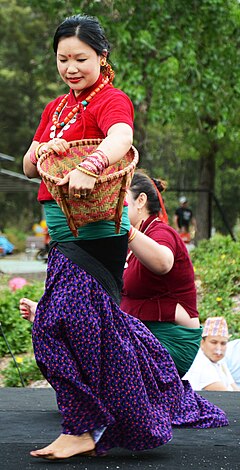Maghe Sankranti
| Maghe Sankranti | |
|---|---|

Basket dance at Maghe Sankranti
|
|
| Observed by | Hindus, Nepal |
| Type | religious, cultural |
| Significance | welcome longer days, sun worship |
| Date | almost always 14 January |
| 2017 date | 14 January |
| 2018 date | 14 January |
| Related to | Makar Sankranti |
Maghe Sankranti (Nepali:माघे सङ्क्रान्ति, Mathili:माघि, Nepal Bhasa:घ्यःचाकु संल्हु) is a Nepalese festival observed on the first of Magh in the Vikram Sambat (B.S) calendar (about 14 January) bringing an end to the winter solstice containing month of Poush. Maghe Sankranti is similar to solstice festivals in other religious traditions.
Observant Hindus take ritual baths during this festival, notably at auspicious river locations. These include Sankhamul on the Bagmati near Patan; In the Gandaki/Narayani river basin at Triveni, Devghat near Chitwan Valley and Ridi on the Kaligandaki; and in the Koshi River basin at Dolalghat on the Sun Koshi. Festive foods like laddoo, ghee and sweet potatoes are distributed. The mother of each household wishes good health to all family members.
Generally makar sankranti falls on 14 January, and is called Makar Sankranti or other names in the Indian subcontinent. Maghe Sankranti is a major harvest festival celebrated in Madhesh and Tharuhat of Nepal. The movement of the sun from one zodiac sign into another is called Sankranti and as the Sun moves into the Capricorn zodiacal sign known as Makara, this occasion is named as Makara Sankranti in the Pahari context. It is one of the few Nepalese festivals of Madhesi and Tharu people that are celebrated on a fixed date, i.e., 14 January because this solar festival in the honor of deity Surya follows the solar cycle of the Bikrami calendar, unlike other festivals that follow lunar cycle.
...
Wikipedia
